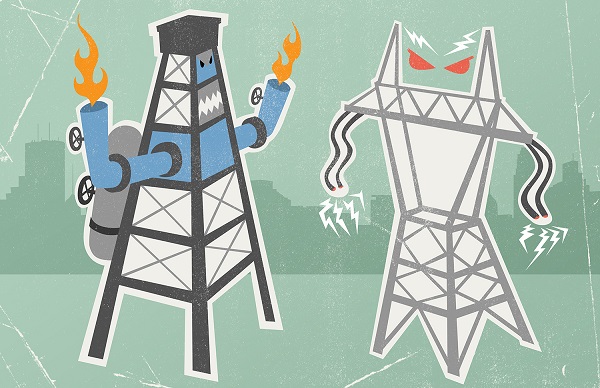Advanced location analytics assist gas utilities in the face of growing demand—and growing competition.
Natural gas and electric distribution utilities compete to bring energy to homes and businesses for heating purposes. Today, these utilities continue a long-running battle to gain market share at the expense of each other. Stakes are high. Generally, the winner supplying energy for heating has some competitive advantage in supplying energy for hot water and cooking. But not necessarily.
At times, executives responsible for customer growth in natural gas distribution envy their peers in water and electric distribution. Virtually every household and business needs water and electricity for some purpose. That’s not the case for natural gas.

Although natural gas is an attractive energy choice, distributors have to work hard to persuade prospective customers to choose it as a preferred fuel. Often utilities found this effort on proactive economic development, meant to drive businesses and industries to their service territories. Meanwhile, their colleagues apply marketing analytics to project the size and location of expected business and population growths. The utilities often collaborate with local government planners and real-estate developers. Houses go up, building permits get submitted, and data-record analyses ensure strategic decision-making.
Location in Data
All these data records share a location element. We all have heard “Location! Location! Location!” It’s what drives where homeowners shop and why businesses start in certain areas. Geographic information, then, and the GIS that provides advanced location analytics assist gas utilities in these customer-growth initiatives. This is why Esri has included targeted pre configurations of its ArcGIS platform to meet gas utilities’ needs, which are available in the ArcGIS for Gas Utilities solution suite.
Gas Service Lookup is a great example. This pre configuration of ArcGIS Online lets customers (i.e., the public) view for themselves if gas service is available in a given location, such as a home address. Your utility can embed this app in its own website as opposed to having to build a standalone application. You can even use the same app as a marketing and customer-service tool by enabling a request-tracking feature. By tracking the use of the app, you’ll collect the location of each point inquired about in the service-lookup.
Another customer-facing example is the Upselling to Existing Customers pre configuration. This lets you easily identify customers most likely to purchase additional services. The upselling solution uses Esri Maps for Office to quickly map the location of your customers and then geoenrich the data with additional factors to identify your most likely target market for, say, a gas furnace upgrade. By publishing these results to your organization’s ArcGIS Online account, you can then share your findings with specific groups within your utility, such as the marketing team and salesforce.
Finally, the Potential New Customer solution lets you identify prospect customers near existing gas mains. By entering land parcels with no gas meters associated and then comparing these parcels to the location of your existing gas mains, you can focus the marketing department’s efforts. All of this internal collaboration happens in real time, thanks to quick information sharing through ArcGIS Online.
The Full Reach of Location
Beyond these examples of focused maps, apps, and services, the ArcGIS platform provides easy-to-use and powerful analytical capabilities to support sales and marketing efforts. Field staff can use the platform daily, such as to locate and record size estimations of above-ground propane tanks during inspection. They can share their findings with the marketing department to find ideal candidates for conversions to piped gas. In addition, the era of omnipresent tablets and smartphones let utilities put all this information in the hands of the salespeople calling on target businesses and industrial candidates.
Utility competition is going to continue for many years. In this battle for business, the growth forecast for private and commercial use of natural gas remains very positive. Our outlook is fueled (pun intended) by a growing ability of geographic information—enabled by the ArcGIS platform—to facilitate the discovery, use, creation, and sharing of maps.
Have you fueled yourself on the full power of the ArcGIS platform?
—–
Learn more about ArcGIS solutions for gas utilities.